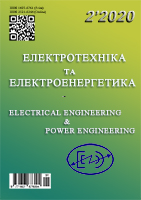Improvement of the evaluation method of calculation of power losses in power transformer
DOI:
https://doi.org/10.15588/1607-6761-2020-2-4Keywords:
, power losses, power transformer, efficiency, analytical and calculation method, transformer efficiencyAbstract
Purpose. The purpose of the work is to perform analytical analysis of methods for calculating power losses of a power transformer and to improve the estimation method of calculation to increase the accuracy of calculating power losses on the example of an industrial power transformer.
Methodology. Analytical and calculation method was used to determine power losses in the power transformer.
Findings. Analysis of the main power losses of power transformers is an important task to determine the optimal conditions for their operation. Analytical analysis of transformer power loss calculation methods is carried out. The relative contribution of different types of power losses is shown. The calculation of energy losses of the power transformer TM 1000/10/0.4 is performed. The losses of active and reactive energy of the transformer are determined. The efficiency of the power transformer is calculated. A generalizing formula for determining the efficiency of the transformer is proposed.
Originality. On the basis of the analytical analysis of methods of calculation of power losses of the power transformer the estimation technique is improved and calculation of losses of active and reactive energy of the industrial power transformer TM 1000/10/0.4 is carried out. A new generalizing formula for determining the efficiency of a power transformer, which takes into account the operating time of the transformer at maximum load, is proposed.
Practical value. The estimation method for calculating the power losses of an industrial power transformer under load is improved, in which a generalizing formula for determining the efficiency of a transformer is applied. The proposed technique simplifies the calculations, reduces the estimated time to determine the operating parameters of the power transformer with the required accuracy. The proposed technique was tested on the example of the power transformer TM 1000/10/0.4. It is shown that with increasing maximum load time, the efficiency of the transformer increases and asymptotically approaches the maximum value.
References
[1] Kulkarni S.V., Khaparde S.A. (2013). Transformer Engineering Design, Technology, and Diagnostics. CRC Press, 742.
[2] Moser H.P., Dahinden V. (1999). Transformerboard 2. Graphics DOK MAN, 222.
[3] Larin V.S. (2015). Silovye transformatory. Moskva, Znak, 391.
[4] Silovye transformatory. Spravochnaja kniga (2004)/ Pod red. S.D. Lizunova, A.K. Lohanina. M. Jenergoizdat, 616 s.
[5] Biki, M. A. (2013). Proektirovanie silovyh transformatorov. Raschety osnovnyh parametrov. M. Znak, 612.
[6] Lejtes, L. V. (1981). Jelektromagnitnye raschety transformatorov i reaktorov. M. Jenergija, 392.
[7] Fursanov M.I. (2005). Opredelenie i analiz poter' jelektrojenergii v jelektricheskih setjah jenergosistem. — Mn.: UVIC pri UP «Beljenergosberezhenie», 208.
[8] Ivankov, V., Basova, A., & Shulga, N. (2014). Elec-tric-heatings calculation models of structural ele-ments of transformer equipment. Electrical Engineering and Power Engineering, 2, 41-53. doi:http://dx.doi.org/10.15588/1607-6761-2014-2-6
[9] Ostrenko, M., & Tykhovod, S. (2016). Raschet poter' v jelementah konstrukcii silovyh transformatorov i reaktorov metodom konechnyh jelementov s granichnymi uslovijami impedansnogo tipa. Elektrotehnika i elektroenergetika, 2, 33-42. doi:http://dx.doi.org/10.15588/1607-6761-2016-2-4
[10] Ivankov, V., & Basova, A. (2019). Calculation of the geomagnetic induced currents impact on the high-power transformer. Electrical Engineering And Power Engineering, 4, 8-20. doi:http://dx.doi.org/10.15588/1607-6761-2019-4-1
[11] Juan C. Olivares-Galván, Pavlos S. Georgilakis & Rodrigo Ocon-Valdez (2009). A Review of Transformer Losses. Electric Power Components and Systems, 37:9, 1046-1062, DOI:10.1080/15325000902918990
[12] Takach, D. S., Boggavarapu, R. L. (1985). Distribution transformer noload losses. Power Appar. Syst. IEEE Trans., 1, 181-193. DOI: 10.1109/TPAS.1985.318892
[13] Michal Kolcun, Anna Gawlak, Miroslaw Kornatka, Zsolt Čonka (2020). Active and Reactive Power Losses in Distribution Transformers. Acta Polytech-nica Hungarica, 17, 1, 161-174.
[14] Krasovskiy, P. (2015). Calculation of power losses in power transformers considering the operation life. Electrification of Transport, 10, 74-80.
[15] Zorin, V., Buyniy, R., & Perepecheniy, V. (2015). Modeli i metody rascheta i ocenki poter' moshhnosti i jelektricheskoj jenergii v raspredelitel'nyh setjah 0,38 kV. Jenergosberezhenie. Jenergetika. Jenergoaudit, 5, 19-27.
[16] Ded, A.V., Parshukova, A.V., Halitov, N.A. (2015). Ocenka dopolnitel'nyh poter' moshhnosti ot nesimmetrii naprjazhenij i tokov v jelementah sistem jelektrosnabzhenija. Mezhdunarodnyj zhurnal prikladnyh i fundamental'nyh issledovanij,10-3, 421-425.
[17] Metodichnі rekomendacії viznachennja tehnologіchnih vitrat elektrichnoї energії v transformatorah і lіnіjah elektroperedavannja. https://www.energy.mk.ua/index.php/77-akcia-razdel/akcia-kategoria/634-metodika9.html
[18] Strnat, K.J. (1990). Modern Permanent Magnets for Application in Electro-Technology. Proceedings of the IEEE, 78, 6, 923-925. DOI: 10.1109/5.56908
[19] G. Bertotti, (1988). General properties of power losses in soft ferromagnetic materials. Magn. IEEE Trans., 24, 1, 621-630. DOI: 10.1109/20.43994
[20] Stefan Fassbinder (2013). Efficiency and Loss Evaluation of Large Power Tranformers, ECI Publication No Cu0144, Issue 01, Available from www.leonardo-energy.org.
[21] Proskurjakov, V.S., Sobolev, S.V. (2009). Tehnicheskie dannye i jekspluatacionnye harakteristiki transformatora. Virtual'nyj praktikum. Uchebnoe jelektronnoe tekstovoe izdanie. Ekaterinburg, GOU VPO UGTU−UPI, 26.
[22] https://opori-osveshenia.ru/sovety/elektricheskie-poteri.html
Downloads
How to Cite
Issue
Section
License
Copyright (c) 2020 O.S. Pidlisniy O.S., S.P. Lushchin

This work is licensed under a Creative Commons Attribution 4.0 International License.
Creative Commons Licensing Notifications in the Copyright Notices
Authors who publish with this journal agree to the following terms:
Authors retain copyright and grant the journal right of first publication with the work simultaneously licensed under aCreative Commons Attribution License that allows others to share the work with an acknowledgement of the work's authorship and initial publication in this journal.
Authors are able to enter into separate, additional contractual arrangements for the non-exclusive distribution of the journal's published version of the work (e.g., post it to an institutional repository or publish it in a book), with an acknowledgement of its initial publication in this journal.
Authors are permitted and encouraged to post their work online (e.g., in institutional repositories or on their website) prior to and during the submission process, as it can lead to productive exchanges, as well as earlier and greater citation of published work.

